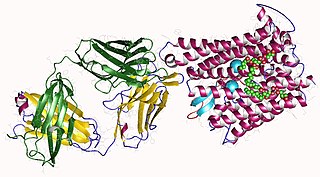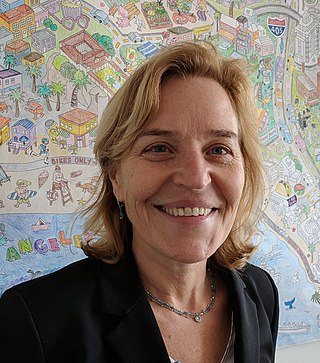Related Research Articles

Iron overload or haemochromatosis indicates increased total accumulation of iron in the body from any cause and resulting organ damage. The most important causes are hereditary haemochromatosis, a genetic disorder, and transfusional iron overload, which can result from repeated blood transfusions.
Roy Lee Walford, M. D. was a professor of pathology at University of California, Los Angeles School of Medicine, a leading advocate of calorie restriction for life extension and health improvement, and a crew member of Biosphere 2.

Erythropoiesis is the process which produces red blood cells (erythrocytes), which is the development from erythropoietic stem cell to mature red blood cell.
Ronald Mark Evans is an American Biologist, Professor and Head of the Salk’s Gene Expression Laboratory, and the March of Dimes Chair in Molecular and Developmental Biology at the Salk Institute for Biological Studies in La Jolla, California and a Howard Hughes Medical Institute Investigator. Dr. Ronald M. Evans is known for his original discoveries of nuclear hormone receptors (NR), a special class of transcriptional factor, and the elucidation of their universal mechanism of action, a process that governs how lipophilic hormones and drugs regulate virtually every developmental and metabolic pathway in animals and humans. Nowadays, NRs are among the most widely investigated group of pharmaceutical targets in the world, already yielding benefits in drug discovery for cancer, muscular dystrophies, osteoporosis, type II diabetes, obesity, and cardiovascular diseases. His current research focuses on the function of nuclear hormone signaling and their function in metabolism and cancer.
Anemia of chronic disease (ACD) or anemia of chronic inflammation is a form of anemia seen in chronic infection, chronic immune activation, and malignancy. These conditions all produce elevation of interleukin-6, which stimulates hepcidin production and release from the liver. Hepcidin production and release shuts down ferroportin, a protein that controls export of iron from the gut and from iron storing cells. As a consequence, circulating iron levels are reduced. Other mechanisms may also play a role, such as reduced erythropoiesis. It is also known as anemia of inflammation, or anemia of inflammatory response.

Human iron metabolism is the set of chemical reactions that maintain human homeostasis of iron at the systemic and cellular level. Iron is both necessary to the body and potentially toxic. Controlling iron levels in the body is a critically important part of many aspects of human health and disease. Hematologists have been especially interested in systemic iron metabolism, because iron is essential for red blood cells, where most of the human body's iron is contained. Understanding iron metabolism is also important for understanding diseases of iron overload, such as hereditary hemochromatosis, and iron deficiency, such as iron-deficiency anemia.

Hepcidin is a protein that in humans is encoded by the HAMP gene. Hepcidin is a key regulator of the entry of iron into the circulation in mammals.

Ferroportin-1, also known as solute carrier family 40 member 1 (SLC40A1) or iron-regulated transporter 1 (IREG1), is a protein that in humans is encoded by the SLC40A1 gene, and is part of the Ferroportin (Fpn)Family (TC# 2.A.100). Ferroportin is a transmembrane protein that transports iron from the inside of a cell to the outside of the cell. Ferroportin is the only known iron exporter.

Michael Grunstein is a Distinguished Professor Emeritus of Biological Chemistry at the David Geffen School of Medicine at UCLA.

Harbor–UCLA Medical Center, is a 570-bed public teaching hospital located at 1000 West Carson Street in West Carson, an unincorporated area within Los Angeles County, California. As implied by the name, the hospital is owned by the Los Angeles County and operated by the Los Angeles County Department of Health Services, while doctors are faculty of the David Geffen School of Medicine at UCLA, who oversee the medical residents being trained at the facility.

Iron is an important biological element. It is used in both the ubiquitous Iron-sulfur proteins and in Vertebrates it is used in Hemoglobin which is essential for Blood and oxygen transport.
Utpal Banerjee is a Distinguished Professor of the Department of Molecular, Cell and Developmental Biology at UCLA. He obtained his Bachelor of Science degree in Chemistry from St. Stephen's College, Delhi University, India and obtained his Master of Science degree in Physical Chemistry from the Indian Institute of Technology, Kanpur, India. In 1984, he obtained a PhD in Chemistry from the California Institute of Technology where he was also a Postdoctoral Fellow in the laboratory of Seymour Benzer from 1984-1988.

James S. Economou is an American physician-scientist on the faculty of the University of California, Los Angeles (UCLA) where he is also a surgical oncologist and tumor immunologist. He was Vice Chancellor for Research at UCLA (2010-2015) where he promoted academic entrepreneurship, transdisciplinary research, and support of the humanities, arts, and social sciences. The UCLA research enterprise generates almost one billion dollars in extramural funds annually.
Elizabeta Nemeth is an American physiologist who has made many contributions to the understanding of inflammatory disorders, thalassemias, and iron overload diseases.
Jonathan Braun is an American professor of pathology and pharmacology who has more than 140 peer reviewed articles.

Erythroferrone is a protein hormone encoded in humans by the ERFE gene. Erythroferrone is produced by erythroblasts, inhibits the production of hepcidin in the liver, and so increases the amount of iron available for hemoglobin synthesis. Skeletal muscle secreted ERFE has been shown to maintain systemic metabolic homeostasis.

Kelsey Martin is a professor of biological chemistry, psychiatry and biobehavioral sciences at UCLA and the director of the Simons Foundation Autism Research Initiative and the Simons Foundation Neuroscience Collaborations. She was the former dean of David Geffen School of Medicine at UCLA from 2015 to 2021., and was the first woman to be named Dean of the UCLA medical school, and was one of just a few female medical school Deans in the United States. She has been the director of the Simons Foundation Autism Research Initiative, Neuroscience Collaborations since September 2021.

Wei Yan is a Chinese-American reproductive biologist, currently Professor of Medicine at David Geffen School of Medicine at UCLA and Senior Investigator at The Lundquist Institute for Biomedical Innovation at Harbor-UCLA Medical Center. He is also University Foundation Professor at University of Nevada, Reno, United States and an Elected Fellow of the American Association for the Advancement of Science. He is Director of National Center for Male Reproductive Epigenomics and served as the editor-in-chief of the journal Biology of Reproduction.
Israel Lyon Chaikoff was a Canadian-American physiologist and biochemist, known for the Wolff–Chaikoff effect. He and his colleagues were pioneers in the use of radioactive iodine (iodine-131) to investigate thyroid function.
Patricia Anne Ganz is an American medical oncologist. She is a professor of health policy and management in the Fielding School of Public Health and a professor of medicine in the David Geffen School of Medicine at UCLA. In 2007, she was elected to the Institute of Medicine.
References
- ↑ "Tomas Ganz ORCID". ORCID. June 20, 2019. Retrieved June 20, 2019.
- ↑ "Marcel Simon Award".
- ↑ E. Donnall Thomas Award
- ↑ Ganz, Tomas (2014). "Identification of erythroferrone as an erythroid regulator of iron metabolism". Nature Genetics. 46 (7): 678–84. doi:10.1038/ng.2996. PMC 4104984 . PMID 24880340.
- ↑ "Tom Ganz, M.D., Ph.D." David Geffen School of Medicine. Retrieved June 20, 2019.